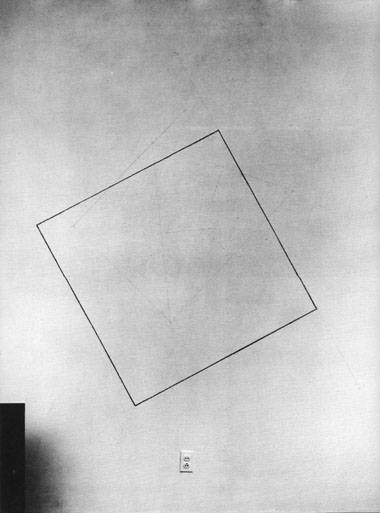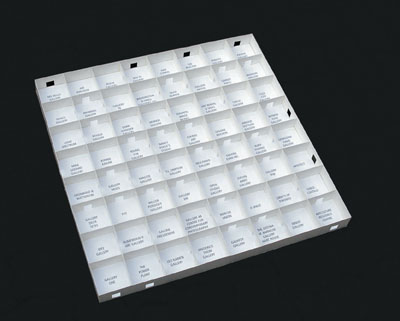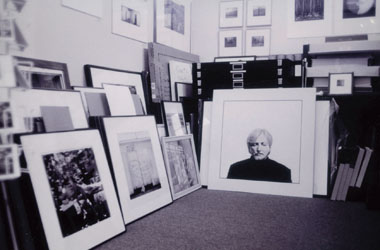The Art Behind dArt
dArt Magazine: Ten Years of Meditations on Space
by Steve Rockwell
Since the subject is space, I will simply fill the page with words. If anyone is curious as to what I am using to accomplish it, the font is Frutiger. The name Steve Rockwell itself is made up of two type fonts, Steve and Rockwell, making Steve Rockwell a pure print construction. The precise moment was April 12, 1987, when a ‘meteor’ in the Gutenburg galaxy, an amalgamate of vowels, consonants, and serifs, streaked through the atmosphere and plunged to earth. Steve, a Letraset font, was an early bit-map typeface, possibly inspired by the dot matrix printers of old. The Rockwell font goes back further in time, and with its blunt serifs is a common Egyptian face.
 How did Steve come to be? The glint in my eye was an Art in America article on conceptual artist Sol LeWitt by Donald Kuspit called, The Look of Thought. What got it going, was a full page reproduction of LeWitt’s The Location of a Square 1974, a wall drawing rendered in pencil and black crayon. The accompanying description in the article went on to say, "The faintly visible network of penciled lines behind the square plots a series of points which determine the location of the square on any particular wall... The size and shape of the wall have a crucial relationship to both the size and placement of the square." How did Steve come to be? The glint in my eye was an Art in America article on conceptual artist Sol LeWitt by Donald Kuspit called, The Look of Thought. What got it going, was a full page reproduction of LeWitt’s The Location of a Square 1974, a wall drawing rendered in pencil and black crayon. The accompanying description in the article went on to say, "The faintly visible network of penciled lines behind the square plots a series of points which determine the location of the square on any particular wall... The size and shape of the wall have a crucial relationship to both the size and placement of the square."
LeWitt’s written instructions to actually execute the drawing, I found to be arcane and downright dull, but what they accomplished was impressive. I liked that the artist wasn’t required in the final rendition of the ‘art’. With removal, a score or program was produced, making transparent the process by which art is made, applying a rinse to murky psychology and metaphysics. In other words, ‘space’ was inserted between an idea and its execution. Someone else besides the artist might occupy the space, carrying out the art- making motions devoid of creative machinations.
 My response to LeWitt’s The Location of a Square and his Large Incomplete Cubes, was a floor sculpture entitled Gallery Space, an unabashed homage to LeWitt. Where we differed was in the nature of the ‘program’ used to generate the work. In the place of LeWitt’s complicated instructions, I inserted a fictitious persona, Steve Rockwell, to manage the information and its generation. I equipped Steve with portfolio stuffed with a two by two foot model of the intended sculpture, plus forms for participants to fill out. Steve’s wardrobe was a sports jacket, dress pants, black dress shoes, and a few bad jokes. Having conceived of the general look of the final piece, formal variations in the details of the intended work to be, would be determined by the incremental involvement of subsequent participants. My response to LeWitt’s The Location of a Square and his Large Incomplete Cubes, was a floor sculpture entitled Gallery Space, an unabashed homage to LeWitt. Where we differed was in the nature of the ‘program’ used to generate the work. In the place of LeWitt’s complicated instructions, I inserted a fictitious persona, Steve Rockwell, to manage the information and its generation. I equipped Steve with portfolio stuffed with a two by two foot model of the intended sculpture, plus forms for participants to fill out. Steve’s wardrobe was a sports jacket, dress pants, black dress shoes, and a few bad jokes. Having conceived of the general look of the final piece, formal variations in the details of the intended work to be, would be determined by the incremental involvement of subsequent participants.
The data harvest required more than a year to gather. In all, 64 art galleries in Toronto consented to take part – just under a half a dozen declined. The resulting work is illustrated on the next page. Below it is a scan of Gallery Space Form #23. In retrospect, the full quiver of 64 forms constitute an intriguing slice of 1988 art gallery history. The work was exhibited at the Arnold Gottlieb Gallery in January 1989 along with other Steve Rockwell art involvement pieces.
 Spatial concerns culminated into a book work in 1995 with the launch of Meditations on Space. This time the global arc had widened to three countries, six cities, and involved 175 art galleries. Beginning at Galerie Bruno Bischofberger in Zürich, Switzerland in September 1995, I capped the jaunt in Los Angeles in January 1997. The introduction of written text to the project laid the foundation, only a year later, to dArt International magazine. An image makeover for Steve Rockwell included a goatee and a turtleneck for gloomy weather. The style was 1950s coffee house without the beret. Steve’s ‘Odyssey’ was assigned to Jack Kerouac, while Soren Kierkegaard would handle all the serious meditations on it. Spatial concerns culminated into a book work in 1995 with the launch of Meditations on Space. This time the global arc had widened to three countries, six cities, and involved 175 art galleries. Beginning at Galerie Bruno Bischofberger in Zürich, Switzerland in September 1995, I capped the jaunt in Los Angeles in January 1997. The introduction of written text to the project laid the foundation, only a year later, to dArt International magazine. An image makeover for Steve Rockwell included a goatee and a turtleneck for gloomy weather. The style was 1950s coffee house without the beret. Steve’s ‘Odyssey’ was assigned to Jack Kerouac, while Soren Kierkegaard would handle all the serious meditations on it.
At Peter Blum Gallery in New York Blum quipped: "Is it possible to meditate on space at Bruno Bischofberger?"
An earnest quote in the final Meditations on Space entry from Zero One Gallery in LA bears mentioning: "I asked gallery artist Kyle Lind about the meaning of zero and one, and ventured an explanation. Kyle said, "No, a lot of people think it’s binary. Zero is when there’s nothing – one when there’s something. The space between the zero and the one is the creative act."
The lead story in the first issue of dArt was on gallery dogs, with a cover photo of Stuart Regen in Los Angeles. I had taken some shots of Stuart’s attempt to pose Gordo as documentary background for this particular narrative item: "I walked from North Almont and down the lane to the Regen Projects gallery. Gordo, the dog, observed my approach. Chip said, ‘Gordo is like the symbol of the gallery. He’ll lick you to death.’ Gordo jumped up on me. Chip said, ‘Down, Gordo! Down!’"
I wrote the first issue of dArt myself, regarding it more as an extension of my Meditations than a conventional magazine, and planned to fire the ‘darts’ one at a time with no aim to longevity.
With dArt issue #2, Jan Tümlir and Michael Darling contributed Los Angeles content. Carl Skelton and Corinna Ghaznavi covered the east coast. The entire story of dArt with a full list of its contributors and attendant stories requires its own ‘space,’ and while in its tenth year it is still very much unfolding.
It seemed fitting with this tenth anniversary issue to feature on the 21st cover of dArt, the work of Brazilian artists Giselle Beiguelman and Vera Bighetti and their Improbable Architectures, provided by Second Life, an online virtual reality platform, where net and real world locations are integrated into a single artwork.
To some extent, with the speed of communication and the ease with which information content may be encrypted, we have all become "spatial practitioners." Information systems like weather patterns are self-integrating systems, and global connectedness has altered how we think and act locally.
|